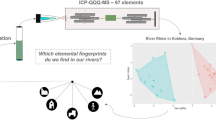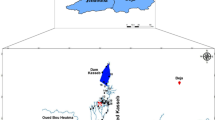Abstract
Purpose
Multidisciplinary research was carried out to verify the best approach for a reliable assessment of sediment quality in marine areas affected by strong metal enrichment. The study was carried out on Sulcis-Iglesiente marine coastal areas (Sardinia, Italy), where a long-lasting past mining operation strongly contaminated marine sediments with heavy metals (Cd, Pb and Zn).
Materials and methods
Surface sediments were analysed for grain size and mineralogical content, total organic carbon, total metal concentrations and sequential extractions. Additionally, ecotoxicological bioassays were performed using Vibrio fischeri (Microtox®) on the solid phase and elutriate, Dunaliella tertiolecta on elutriate and Brachionus plicatilis on elutriate.
Results and discussion
Analysed sediments were nearly exclusively sand (98.5–100%) with a very low TOC content; their texture and mineralogy indicated a N-S drift affecting the dispersion of mining contributions. The total concentrations of Cd, Pb and Zn, which are positively correlated, exceeded background and Environmental Quality Standards (EQS) values by up to two orders of magnitude, while sequential extractions revealed their high mobility because Cd and Pb were mainly extracted in the first phase (up to 77 and 82%, respectively) and Zn in the second phase (up to 99%). In spite of this, bioassays recorded the absence of toxicity in all the samples.
Conclusions
These apparently conflicting results suggest that ecotoxicological tests cannot replace chemical analyses in sediment quality assessments because they could fail to provide reliable information on the bioavailability of contaminants over time.





Similar content being viewed by others
References
Ahlf W, Hollert H, Neumann-Hensel H, Ricking M (2002) A guidance for the assessment and evaluation of sediment quality. A German approach based on ecotoxicological and chemical measurements. J Soils Sediments 2(1):37–42
Antunes SC, de Figueiredo DR, Marques SM, Castro BB, Pereira R, Gonçalves F (2007) Evaluation of water column and sediment toxicity from an abandoned uranium mine using a battery of bioassays. Sci Total Environ 374(2-3):252–259
APAT-ICRAM (2007) Manual for the handling of marine sediments, 77 pp
ASTM international (1998) E 1440-91 - Standard guide for acute toxicity test with the Rotifer Brachionus, pp 806–813
Aversa G, Balassone G, Boni M, Amalfitano C (2002) The mineralogy of the “Calamine” Ores in SW Sardinia (Italy): preliminary results. Period Mineral 71:201–218
Besser JM, Brumbaugh WG, Ingersoll CG (2015) Characterizing toxicity of metal-contaminated sediments from mining areas. Appl Geochem 57:73–84
Birch G (2003) A scheme for assessing human impacts on coastal aquatic environments using sediments. In: Woodcoffe CD, Furness RA (eds) Coastal GIS 2003. Wollongong University Papers in Center for Maritime Policy, Australia
Boni M, Iannace A, Bechstädt T, Gasparrini M (2000) Hydrothermal dolomites in SW Sardinia (Italy) and Cantabria (NW Spain): evidence for late- to post-Variscan widespread fluid-flow events. J Geochem Explor 69-70:225–228
Caeiro S, Costa MH, Ramos TB, Fernandes F, Silveira N, Coimbra A, Medeiros G, Painho M (2005) Assessing heavy metal contamination in Sado Estuary sediment: an index analysis approach. Ecol Indic 5:151–169
Caliani JC, Ruiz Muñoz F, Galán E (1997) Clay mineral and heavy metal distributions in the lower estuary of Huelva and adjacent Atlantic shelf, SW Spain. Sci Total Environ 198:181–200
Campanella L, D’Orazio D, Petronio BM, Pietrantonio E (1995) Proposal for a metal speciation study in sediments. Anal Chim Acta 309(1-3):387–393
Carmignani L, Barca S, Oggiano G, Pertusati PC, Salvadori I, Conti P, Eltrudis A, Funedda A, Pasci S (2001) Note illustrative della Carta Geologica della Sardegna a scala 1:200.000. In: Memorie descrittive Carta Geologica Italiana, Roma
Carta Geologica d’Italia (n.d.) Foglio 224-225 “Capo Pecora - Guspini”. Scala 1:100.000
Chapman PM (1990) The sediment quality triad approach to determining pollution-induced degradation. Sci Total Environ 97-98:815–825
Cidu R (2009) Impact of past mining activity on the quality of groundwater in SW Sardinia (Italy). J Geochem Explor 100:125–132
Cidu R (2011) Mobility of aqueous contaminants at abandoned mining sites: insights from case studies in Sardinia with implications for remediation. Environ Earth Sci 64(2):503–512
Cidu R, Fanfani L (2002) Overview of the environmental geochemistry of mining districts in southwestern Sardinia, Italy. Geochem-Exp Environ Anal 2(3):243–251
Cidu R, Biddau R, Nieddu G (2007) Rebound at Pb-Zn mines hosted in carbonate aquifers: influence on the chemistry of groundwater. Mine Water Environ 26:88–101
Cidu R, Dadea C, Desogus P, Fanfani L, Manca PP, Orrù G (2012) Assessment of environmental hazards at abandoned mining sites: a case study in Sardinia, Italy. Appl Geochem 27:1795–1806
Cillari T, Finoia MG, Onorati F, Pulcini M, Mugnai C, Ausili A, Sunseri G (2011) Integrated physical-chemical and ecotoxicological approach in the management of dredging sediments from Palermo Harbour. Chem Ecol 27(2):25–37
De Giudici G, Wanty RB, Podda F, Kimball BA, Verplanck PL, Lattanzi P, Cidu R, Medas D (2014) Quantifying biomineralization of zinc in the rio Naracauli (Sardinia, Italy), using a tracer injection and synoptic sampling. Chem Geol 384:110–119
De Giudici G, Pusceddu C, Medas D, Meneghini C, Gianoncelli A, Rimondi V, Podda F, Cidu R, Lattanzi P, Wanty RB, Kimball BA (2017) The role of natural biogeochemical barriers in limiting metal loading to a stream affected by mine drainage. Appl Geochem 76:124–135
Doglioni C, Fernandez M, Gueguen E, Sábat F (1999) On the interference between early Apennines Maghrebides back arc extension and Alps Betics orogen in the Neogene Geodynamics of the Western Mediterranean. Boll Soc Geol Ital 118:75–89
Dou Y, Li J, Zhao J, Hua B, Yang S (2013) Distribution, enrichment and source of heavy metals in surface sediments of the eastern Beibu Bay, South China Sea. Mar Pollut Bull 67:137–145
Frau F, Medas D, Da Pelo S, Wanty RB, Cidu R (2015) Environmental effects on the aquatic system and metal discharge to the Mediterranean sea from a near-neutral zinc-ferrous sulphate mine drainage. Water Air Soil Pollut 226:2339–2356
Hammer Ø, Harper DAT, Ryan PD (2001) PAST: paleontological statistic software package for education and data analysis. Palaeontol Electron 4(1):9
ICRAM (2001) Metodologie Analitiche di Riferimento. Programma di monitoraggio per il controllo dell’ambiente marino costiero (triennio2001-2003). Cicero AM, Di Girolamo I (eds) Ministero dell’Ambiente e della Tutela del Territorio e del Mare
ISPRA (2015) Caratterizzazione ambientale dell’area marino costiera prospiciente il sito di bonifica di interesse nazionale del Sulcis-Iglesiente-Guspinese. Risultati analitici e valutazione dei dati. Technical Report, 120 pp
Jain CK (2004) Metal fractionation study on bed sediments of River Yamuna, India. Water Res 38:569–578
Kowalewska G, Belzunce-Segarra MJ, Schubert B, Heininger P, Heise S (2011) The role of sediments in coastal monitoring. In: Quevauviller P, Roose P, Verreet G (eds) Chemical Marine Monitoring: Policy Framework and Analytical Trends. John Wiley & Sons, Ltd, pp 377–395
Li YH, Schoonmaker JE (2003) Chemical composition and mineralogy of marine sediments. In: Holland HD, Turekian KK (eds) Sediments, Diagenesis, and Sedimentary Rocks, Treatise on Geochemistry. Elsevier 7:1–35
Liu H, Li L, Yin C, Shan B (2008) Fraction distribution and risk assessment of heavy metals in sediments of Moshui Lake. J Environ Sci 20:390–397
Long ER, Chapman PM (1985) A sediment quality triad: measures of sediment contamination, toxicity and infaunal community composition in Puget Sound. Mar Pollut Bull 16:405–415
Loring DH (1991) Normalization of heavy-metal data from estuarine and coastal sediments. ICES J Mar Sci 48:101–115
Maggi C, Bianchi J, Dattolo M, Mariotti S, Cozzolino A, Gabellini M (2006) Fractionation studies and bioaccumulation of cadmium, mercury and lead in two harbour areas. Chem Speciat Bioavailab 18(3):95–103
Manca E, Pascucci V, Deluca M, Cossu A, Andreucci S (2013) Shoreline evolution related to coastal development of a managed beach in Alghero, Sardinia, Italy. Ocean Coast Manag 85:65–76
Marín-Guirao L, Atucha AM, Lloret Barba J, Martínez López E, García Fernández AJ (2005) Effects of mining wastes on a seagrass ecosystem: metal accumulation and bioavailability, seagrass dynamics and associated community structure. Mar Environ Res 60(3):317–337
Mecozzi M, Onorati F, Oteri F, Sarni A (2008) Characterization of a bioassay using the marine alga Dunaliella tertiolecta associated with spectroscopic (visible and infrared) detection. Int J Environ Pollut 32(1):104–120
Medas D, Cidu R, Lattanzi P, Podda F, Wanty RB, De Giudici G (2012) Hydrozincite seasonal precipitation at Naracauli (Sardinia, Italy): hydrochemical factors and morphological features of the biomineralization process. Appl Geochem 27(9):1814–1820
Nieto JM, Sarmiento AM, Olías M, Canovas CR, Riba I, Kalman J, Delvalls T (2007) Angel Acid mine drainage pollution in the Tinto and Odiel rivers (Iberian Pyrite Belt, SW Spain) and bioavailability of the transported metals to the Huelva Estuary. Environ Int 33:445–455
Onorati F, Pellegrini D, Ausili A (1999) Valutazione della tossicità naturale nel saggio Microtox in fase solida. La normalizzazione pelitica. Acqua Aria 6:83–89
Parker WC, Arnold AJ (1999) Quantitative methods of data analysis in foraminiferal ecology. In: Sen Gupta BK (ed) Modern Foraminifera. Kluver Publishers, Dordrecht, pp 71–90
Riba I, Delvalls TA, Forja JM, Gómez-Parra A (2002) Influence of the Aznalcóllar mining spill on the vertical distribution of heavy metals in sediments from the Guadalquivir estuary (SW Spain). Mar Pollut Bull 44(1):39–47
Romano E, Bergamin L, Ausili A, Pierfranceschi G, Maggi C, Sesta G, Gabellini M (2009) The impact of the Bagnoli industrial site (Naples, Italy) on sea-bottom environment. Chemical and textural features of sediments and the related response of benthic foraminifera. Mar Pollut Bull 59:245–256
Romano E, Bergamin L, Croudace IW, Ausili A, Maggi C, Gabellini M (2015) Establishing geochemical background levels of selected trace elements in areas having geochemical anomalies: the case study of the Orbetello lagoon (Tuscany, Italy). Environ Pollut 202:96–103
Romano E, De Giudici G, Bergamin L, Andreucci S, Maggi C, Pierfranceschi G, Celia Magno M, Ausili A (2017) The marine sedimentary record of natural and anthropogenic contribution from the Sulcis-Iglesiente mining district (Sardinia, Italy). Mar Pollut Bull 122:331–343
Romano E, Celia Magno M, Bergamin L (2018) Grain size of marine sediments in the environmental studies, from sampling to measuring and classifying. A critical review of the most used procedures. Acta Imeko 7(2):10–15
Rosado D, Usero J, Morillo J (2016) Assessment of heavy metals bioavailability and toxicity toward Vibrio fisheri in sediment of the Huelva estuary. Chemosphere 153:10–17
Singh KP, Mohan D, Singh VK, Malik A (2005) Studies on distribution and fractionation of heavy metals in Gomti river sediments - a tributary of the Ganges, India. J Hydrol 312:14–27
Szava-Kovats (2008) Grain-size normalization as a tool to assess contamination in marine sediments: is the <63 μm fraction fine enough? Mar Pollut Bull 56:629–632
Author information
Authors and Affiliations
Corresponding author
Additional information
Responsible editor: Susanne Heise
Publisher’s note
Springer Nature remains neutral with regard to jurisdictional claims in published maps and institutional affiliations.
Electronic supplementary material
Fig. S2
Principal Component Analysis on the metal and trace element concentrations of the environmental characterization carried out by ISPRA (2015). Component 1 and 2 account for 39.6% and 25.2% of variance, respectively (JPG 162 kb)
Fig. S3
Dendrogram obtained by HCA on grain-size results (JPG 216 kb)
Fig. S4
Particle size distribution curve of samples of cluster A, B1 and B2 (JPG 813 kb)
ESM 1
(XLS 45 kb)
Rights and permissions
About this article
Cite this article
Romano, E., Bergamin, L., Pierfranceschi, G. et al. Conflicting outcomes of an integrated approach to sediment quality assessment in a Sardinian coastal area subjected to mining activities. J Soils Sediments 20, 2630–2640 (2020). https://doi.org/10.1007/s11368-019-02489-y
Received:
Accepted:
Published:
Issue Date:
DOI: https://doi.org/10.1007/s11368-019-02489-y




